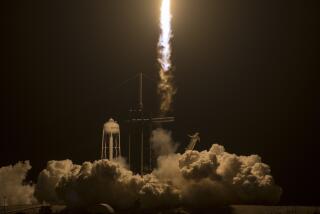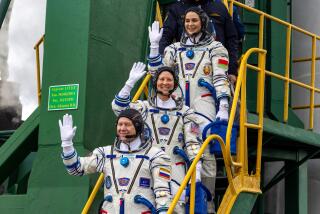After Shaky Start, Cosmonauts Make Risky Mir Repairs
- Share via
KOROLEV, Russia — In another tense chapter of this summer’s thriller aboard the Mir space station, two cosmonauts overcame perilous new failures Friday to make vital repairs and rescue research projects feared lost in the cosmos.
The nearly seven-hour mission to reconnect severed power cables and assess damage to the punctured Spektr research module may mark a turnaround for the luckless, aging Russian space station. But the successes were delayed by more of what has become an almost daily battery of potential disasters.
“We could have called it all off at several points, but we wouldn’t allow ourselves to be knocked from the saddle,” Mission Control chief Vladimir Solovev said.
As Mir commander Anatoly Solovev and flight engineer Pavel Vinogradov donned spacesuits, they were at first thwarted by a faulty valve regulating pressure in the sealed-off transit chamber where they were preparing for an internal spacewalk in the airless Spektr. Solovev readjusted the valve, but then Vinogradov’s spacesuit sprang a leak in the left glove.
With the pressure already down to almost zero, a gush of oxygen from his protective clothing could be heard over the monitors at Mission Control here, bringing the hundreds of officials and journalists gathered to follow the repair mission to a stunned hush.
“This is something serious,” Vinogradov could be heard telling ground controllers. “Yes, I can feel that it is leaking.”
Conscious of the risk of the cosmonaut’s body exploding in a vacuum, Solovev and ground-based flight controllers quickly repressurized the chamber to allow Vinogradov to swap the damaged glove for a spare.
More than two hours behind schedule and rapidly expending precious power and oxygen, the two Russians finally opened the hatch and entered Spektr for the first glimpse of the module since a June 25 accident knocked it out of commission.
Spektr was punctured when an unmanned cargo craft crashed into it during a manual docking practice directed by former Mir commander Vasily Tsibliyev. Four of Mir’s 10 solar energy panels are arrayed outside Spektr and have been isolated since the crash, leaving the space station to limp along on about half its normal power.
Vinogradov managed to reconnect nine battery cables and two sockets, ground controllers reported later; the cosmonauts spent the next two hours poring over the research module in an attempt to find the hole put there by the cargo capsule.
“To our great disappointment, the crew did not notice any visible penetration marks,” said Solovev, the mission control chief who shares the same last name as the Mir commander but is not related.
During their search of Spektr, the cosmonauts did salvage some data from experiments conducted there before the crash. And they brought out some items belonging to NASA astronaut Michael Foale, including his long-lost toothbrush and a photograph of his wife.
Foale, who manned the Soyuz escape capsule while his fellow crewmen roamed his former living quarters, could be heard telling Vinogradov by radio where to look in the drawers of his locker for data and gear. “I think this has been a super day,” the British-born Foale declared as the cosmonauts concluded their mission. “We carried out everything we set out to do, and more. Well done, everybody!”
Although Russian Space Agency officials appeared pleased that some of the research data had been rescued, a NASA official noted that the cosmonauts reported seeing water puddled on Spektr’s floor. That could indicate that the module’s laboratory equipment has been exposed to hazardous condensation, he said.
The Mir crewmen have been ordered to rest over the weekend and to wait until Monday to try to recover power from the batteries outside Spektr. Officials here at Mission Control north of Moscow said they hope to have energy flowing from three of the four solar panels by the middle of next week.
One of the panels was damaged in the collision and is not expected to be used again. But Mission Control chief Solovev said spare panels could be added to the station.
The cosmonauts are next expected to don their spacesuits and walk into open space Sept. 3, when they will examine the outside of Spektr in a further effort to find the hole.
Spektr would have to be patched and repressurized before Mir’s occupants could again use it for scientific work or living quarters. The research module was Foale’s sleeping and working space until the June collision.
Two other research modules docked at Mir--Kristall and Priroda--have also been shut down in order to conserve power. But they could be put back in use if the station’s power flow was restored.
Just before Solovev and Vinogradov ventured into Spektr, Russian President Boris N. Yeltsin called on his fellow Russians to appreciate the achievements of their cosmonauts and promised more resources for exploring space.
“Russia must not leave the ground it won here, must not relinquish its leading position,” Yeltsin said of Soviet-era victories in the cosmos. “We must not forget that the state of our aerospace complex largely determines the status of Russia as a great power.”
In comments earlier this month, Yeltsin had implicitly criticized Tsibliyev for the June 25 accident, the worst in Mir’s 11-year history, saying that the space station’s woes were largely due to “the human factor.”
But in what passed for a retraction of those stinging words, Yeltsin redeemed himself among space officials with his Friday radio address.
“It is necessary to remember that cosmonauts work in extreme conditions, beyond human abilities,” Yeltsin said. “If they sometimes make mistakes, it’s understandable. Work in extreme situations and constant stress take their toll.”
(BEGIN TEXT OF INFOBOX / INFOGRAPHIC)
Repairing Mir
The crew of the space station Mir have made repairs to the Spektr module that was damaged June 25 during a collision with an unmanned supply ship. Here is how the mission proceeded:
* Start of mission is delayed when cosmonauts Anatoly Solovev and Pavel Vinogradov discover that a docking chamber isn’t fully sealed off from the rest of the Mir. Solovev must remove his spacesuit to reseal it.
* The left glove of Vinogradov’s spacesuit is discovered to have a small leak in the cuff. The transfer module is repressurized so he can replace the gloves.
* Cosmonauts open hatch into Spektr; Vinogradov hears fans spinning and pumps working inside the airless module. “I can hear the sound of a living module,” he tells Mission Control.
* Solovev, who’s been shining a light from just outside Spektr’s entrance as Vinogradov connects unplugged cables, moves into Spektr to help. Repairs go smoothly, with the cosmonauts often breaking into laughter.
* Cosmonauts leave Spektr, completing the repair walk.
****
REPAIR DIFFICULTIES
* A leaking hatch in the docking chamber outside the broken module caused a brief delay.
* A leak was discovered at the point where cosmonaut Vinogradovs left glove attached to his spacesuit. It was replaced by a spare glove.
Source: NASA; Aviation Week via Associated Press
More to Read
Sign up for Essential California
The most important California stories and recommendations in your inbox every morning.
You may occasionally receive promotional content from the Los Angeles Times.











